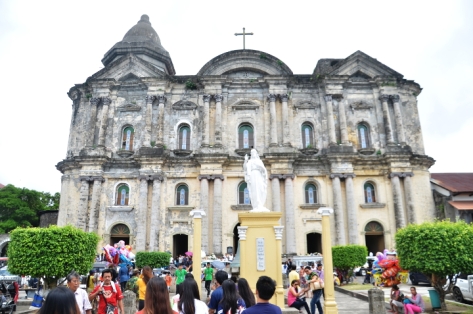Tracing History at the Heritage Town of Taal
by Danny Tariman
It was a long weekend, as Monday was a special holiday. It was another opportunity for my family to travel!
My family started to drive to this 400-year-old town in Batangas early in the morning. Our idea is to eat lunch in Taal. We left our home at about 9am, and drove straight to South Luzon Expressway, to the STAR Tollway exiting at the city of Lipa.
After almost 2 hours of leisure drive, we reached the town of Alibagbag – a town before Taal – had a pit stop at its church. We offered some prayers inside. We then had the usual photo-ops. It was a very new church, and the opposite side of the street is the town plaza.

Another 15 more minutes of driving, we reached the old town of Taal. Wow, as we entered it, I was drawn to the old houses lining the streets. If I were not driving, I would have continuously took photos while we were moving. Haha!
Finally, we pulled our car at the parking area in front of Casa Real, the town’s old municipal hall, just in front of the famous Taal Chuch – the Basilica of Saint Martin of Tours.
The old church is about 150 years old from the time of its final construction. It is declared as a “National Heritage” site, and is described as the “Asia’s Biggest Cathedral”. We toured around the big church with its amazing ceiling and arches. When you look up, you will really be attracted by its beauty!

While touring the inside of the church, we met an old priest who invited to go and visit the “Bahay Pari” or the priests’ house.
We were awed and surprised at the antique get-up of the convent. I feel I am inside a museum! Old religious figures, house furniture, and items from past generations were on display. It was really an experience for us family. It took us a while to shoot each and every nook because, indeed, they were all worth the photos!

Before we knew it, it was already lunch time!
We walked to the other side of the road and wow, you can see rows of ancestral houses lining the streets!
We looked for a place to eat where local dishes and delicacies are served. At first, we were pointed to an upscale restaurant, but checking its menu, we decided to look for authentic Taal or Batangas local eatery.
We were not failed, as just a few more steps, we saw this small restaurant which offers “lomi” – a local noodles oozing with strips of pork, liver, fish ball, and others in rich, thick sauce. This is something we cant find in Manila. And so we went for it! At Php40 per bowl for the “special” dish, it was really filling!
We went to the Basilica’s church bell tower. Oh, it was an experience too. We had to pass by a very narrow staircase leading to the top – it was so constricting; only one person can pass at a time! It was dark too, if not for the small electric bulbs lighting the way. We finally reached the clarion bells – which I think was mechanized lately, because in the old time, one has to pull a rope to clang the bell! The bells are electric-driven now.

Further climb, and we reached the window arches. From here, you can have an unobstructed view of the town with a view reaching farther to Taal Lake on one side, and on the other side is the Mt Maculot. Really awesome!
Moving on with our heritage tour, we visited the Apacible House, which is reportedly the first ancestral house which was turned into a museum. Leon Apaciple, according to the house’ guide, is a classmate of the Philippine national hero, Dr Jose Rizal in Ateneo De Manila. On display are household items of the Apacible family: living room, dining room, bed room, kitchen – with old utensils and other items. It has also a prayer room filled with religious items. I was thinking that the family is a well-to-do family with all the house furnishing it got!

Another house-turned-museum we visited is the Agoncillo ancestral house. This is the house where the first Philippine flag was hand sewed by Marcella Agoncillo. This flag was first raised in Kawit, Cavite – the seat of Philippine independence. We visited all of the rooms available for tourists: living room, dining room, bedroom, the balcony (azotea), and others.
We took time to visit the Caysasay Church where the old image of the Immaculate Concepcion is kept. The image was “fished” out of the river, reportedly, after the eruption of Taal volcano. A few meters from the back of the church is a wellspring, from which water has some healing ability, according to local folks.

Around the town’s public market are several shops offering Filipino dresses made of local piña cloth. You can also try native rice cakes of various varieties. But what looks appealing to my taste-buds are the “kalamay” and the Batangas “lomi”.
Driving back, we passed by the lakeside road via Lemery, leading to Tagaytay City. It was an easy drive as only few vehicles pass by the road.
Another day of family adventure, another wonderful time spent together as family! Thank You LORD!








